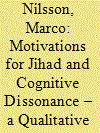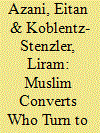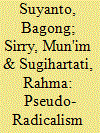|
|
|
Sort Order |
|
|
|
Items / Page
|
|
|
|
|
|
|
| Srl | Item |
| 1 |
ID:
188001


|
|
|
|
|
| Summary/Abstract |
In his November 2018 article, “The Salafi Worldview and the Hermeneutical Limits of Mainstream Sunni Critique of Salafi-Jihadism” in Studies in Conflict & Terrorism,1 Adis Duderija argues that “mainstream Sunnism” shares “the Salafi worldview” as well as certain “epistemological, hermeneutical, interpretational and methodological mechanisms” and “modes of reasoning” in common with the ideology of the “Islamic State” (IS)2 as presented in the group’s magazine Dabiq. (I will refer to this argument as Thesis 1.) For the author, the consequence of those theological “affinities” and similarities between mainstream traditionalist Sunnism and the IS religious ideologies is that the former is incapable of invalidating, countering, rebutting the latter (of rendering the beliefs and violent and harmful practices of Salafi-jihadist groups like the IS “hermeneutically unreasonable”) on matters such as enslavement of female captives, apostasy, or terrorist violence, because both religious cultures (mainstream Sunnism and IS ideology) share too much in common.
|
|
|
|
|
|
|
|
|
|
|
|
|
|
|
|
| 2 |
ID:
187991


|
|
|
|
|
| Summary/Abstract |
When a mass casualty event occurs, why do some people label it terrorism while others do not? People are more likely to consider an attack to be terrorism when the perpetrator is Muslim, yet it is unclear what other factors influence perceptions of mass violence. Using data collected from a national sample of U.S. adults shortly after the 2017 Las Vegas shooting, we examine how media consumption and social identity influence views of the attack. Media consumption and individual-level factors—Islamophobia, political ideology, and other participant demographics—influence how people view the attack and how confident people are in their assessments.
|
|
|
|
|
|
|
|
|
|
|
|
|
|
|
|
| 3 |
ID:
188002


|
|
|
|
|
| Summary/Abstract |
Given that this exchange takes place in an academic setting I will have to start this rejoinder by pointing out that Alain Gabon is neither an Islamic Studies nor Religious Studies scholar. This is important to keep in mind because, if Gabon was such a scholar, he would realize that much, if not all, of his purported critique, given the nature and aims of my article and all of my relevant scholarship in general, is simply misplaced, to put it mildly, or is aimed at intentionally trying to mischaracterize both my scholarship and intentions/motivations behind it (for reasons unknown to me) as will be discussed below. Given that my article focuses on the hermeneutical limits of mainstream Sunnism in countering the theological, epistemological, conceptual, and interpretive (i.e., manhaj-based) aspects of Salafi-jihadism, its main argument can/should only be critically evaluated/appreciated by those scholars who are either.
|
|
|
|
|
|
|
|
|
|
|
|
|
|
|
|
| 4 |
ID:
187994


|
|
|
|
|
| Summary/Abstract |
An extensive body of literature examines how the media depicts female suicide bombers. However, there has been little systematic testing of these theories. I test common arguments about how female bombers are portrayed, relative to male bombers. I find mixed support for the notion that information on female bombers relies on gender stereotypes. I find robust evidence that the marital status of female bombers is more likely to be reported on than for their male counterparts, while other characteristics, such as education and occupation, are not. I discuss the incentives media outlets and armed groups have for reinforcing these stereotypes.
|
|
|
|
|
|
|
|
|
|
|
|
|
|
|
|
| 5 |
ID:
187995


|
|
|
|
|
| Summary/Abstract |
This study is based on interviews with three former Swedish jihadists, and it uses cognitive dissonance theory to analyze how their motivations for jihad changed—from the early stages of radicalization to fighting as part of a jihadist group and finally leaving jihad. It argues that cognitive dissonance is a causal mechanism, alternative to empathy and collective relative deprivation, that can explain how individuals with collective identities can be motivated to opt for jihad. For none of the interviewees did fundamentalist Islam provide a gateway into jihadism, nor did they seem to use Islam as a mere justification for violent behavior. Cognitive dissonance can also shed light on why some jihadists have not been susceptible to further radicalization by accepting even more radical ideas.
|
|
|
|
|
|
|
|
|
|
|
|
|
|
|
|
| 6 |
ID:
187996


|
|
|
|
|
| Summary/Abstract |
Over the past three decades, along with the expansion of the phenomenon of global jihad, we have witnessed a growing trend of converts to Islam integrating into global jihad organizations. Some of these converts constitute an important element in the terrorist infrastructure, globally, and particularly in the West. Some are recruited as foreign fighters into the ranks of the Islamic State or other Islamic extremist organizations. Global jihad organizations have identified the potential of new converts (knowledge of the local culture, the difficulty in tracking them faced by intelligence organizations), and they are investing efforts in every possible arena (physical and digital) to recruit them for terrorist activity. The converts, for their part, are more vulnerable to recruitment for terrorist purposes. The aim of the article is to illuminate the existing phenomenon of radicalization among new converts to Islam and expand the current knowledge base with regard to the variables that affect the growth of this phenomenon and the background and preconditions for such growth. Moreover, this article will attempt to use the above in order to design and develop effective tools for early warning and curbing this phenomenon.
|
|
|
|
|
|
|
|
|
|
|
|
|
|
|
|
| 7 |
ID:
188003


|
|
|
|
|
| Summary/Abstract |
This article contests assertions in Alain Gabon’s response to Adis Duderija’s article “The Salafi Worldview and the Hermeneutical Limits of Mainstream Sunni Critique of Salafi-Jihadism.”1 I demonstrate that Gabon’s response is problematic in three ways: he dismisses legitimate challenges and the debates they have engendered in the field; entirely misses the point of the original article by refuting an argument the original article did not make; and provides a weak refutation that does not withstand scrutiny.
|
|
|
|
|
|
|
|
|
|
|
|
|
|
|
|
| 8 |
ID:
187999


|
|
|
|
|
| Summary/Abstract |
This article discusses a recent phenomenon of radicalization among university students in Indonesia, with special attention to what may be called “pseudo-radicalists” (i.e., a group of students who have been exposed to radical ideologies); however, they are not strongly grounded in an exclusive and extreme religious viewpoint that justifies militant attitudes and violent actions. We carefully and critically examine the extent to which educated youth have been infiltrated by radical influences and how they de-radicalized themselves. Our research includes seven government tertiary institutions identified by the National Agency for Combating Terrorism or Badan Nasional Penanggulangan Terorisme as having been inflicted by radicalism, namely, Universitas Indonesia, Institut Teknologi Bandung, Institut Pertanian Bogor, Universitas Diponegoro, Institut Teknologi Sepuluh Nopember, Universitas Airlangga, and Universitas Brawijaya. By situating our case study within the existing literature on radicalization and de-radicalization, we hope that this article will enrich our perspectives and shed some light on crucial issues facing educated youth, especially within tertiary campuses.
|
|
|
|
|
|
|
|
|
|
|
|
|
|
|
|
| 9 |
ID:
187993


|
|
|
|
|
| Summary/Abstract |
This article reflects on the value and limitations of the use of Freedom of Information (FOI) in the collection of data on counterterrorism policies and practices at museums in the United Kingdom (UK). In doing so, this article re-interprets the museum within the “single narrative” of global jihadist terrorism before using FOI to uncover counterterrorism security measures at museums in the UK. We particularly signpost the importance of the role of the museum security manager as the interface between the museum and the wider UK counterterrorism network. Throughout, but particularly in the discussion section, the article reflects on the value and limitations of FOI as a social research tool. The conclusion highlights the requirement for further qualitative enquiry into the museum as an emerging site of counterterrorism security discourse and practice, particularly in relation to how museum security managers understand and navigate this unique cultural space.
|
|
|
|
|
|
|
|
|
|
|
|
|
|
|
|
| 10 |
ID:
187992


|
|
|
|
|
| Summary/Abstract |
How do rumors emerge and spread? One explanation emphasizes some form of crisis and uncertainty as the facilitating condition and another strand of research focuses on micro-level dynamics to explain how some groups are more vulnerable to rumors than others. This article applies framing theory to examine a rumor that led to violence that killed Farkhunda Malikzada in Afghanistan in March 2015 and three separate protests against the incident. Focusing on how different groups understand and reinterpret rumors, the article makes a distinction between rumor as an informational shortcut and an instrument of deliberate manipulation of information.
|
|
|
|
|
|
|
|
|
|
|
|
|
|
|
|
| 11 |
ID:
187997


|
|
|
|
|
| Summary/Abstract |
The use of international peacebuilding as a delivery vehicle for preventing violent extremism (PVE) initiatives is a recent and pivotal development in United Nations (UN) counterterrorism strategy. However, existing research has not considered the contradictions that emerge when international organizations transition to new peacebuilding approaches such as PVE. Further, it remains unclear whether and how intervening organizations overcome these contradictions. Based on forty-seven interviews with UN, government, and nongovernmental organization officials in Kyrgyzstan and New York this article critically analyzes the shift to PVE as an underlying strategic approach to UN peacebuilding and the mismatch between external expectations and local priorities. Interview narratives feature ambiguity in conceptions of foundational PVE concepts and in how interveners reference a menu of drivers for violent extremism according to project requirements. This article argues that ambiguity is strategically tolerated and employed, whereby not clarifying the terms of engagement with (sub-)national counterparts supports external agendas and achieves a basic unity of purpose by permitting counterparts increased managerial latitude to satisfy self-interests.
|
|
|
|
|
|
|
|
|
|
|
|
|
|
|
|
| 12 |
ID:
187998


|
|
|
|
|
| Summary/Abstract |
Afghanistan faces significant challenges as it seeks to emerge from thirty years of civil war and insurgent violence and promote lasting peace and security. Terrorist incidents, which have increased dramatically since 2004, continue to pose a major threat to security, destabilizing governance and fracturing state initiatives to guarantee rule of law to citizens. An urgent priority for the government, as part of its development of counterterrorism policy, is to ensure that the formal criminal justice system responds effectively to the threat of terrorism by creating mechanisms and procedures that support the rights and needs of victims in accordance with international human rights standards. To date, examining victimhood in Afghanistan and accurately understanding the assistance and support that victims of terrorism receive and to which they are entitled during criminal justice processes have avoided academic scrutiny. Informed by empirical evidence and qualitative interviews with justice officials in Afghanistan, this article aims to fill this important gap in scholarship. It does so by drawing on an international framework for good practices outlined in the Global Counterterrorism Forum’s Madrid Memorandum to shed new light on gaps in existing national law. In doing so, it makes important recommendations for both institutional and legislative reform designed to strengthen protections and assistance for victims of terrorism and inform contemporary reviews of criminal procedural law being undertaken by justice ministries in Afghanistan.
|
|
|
|
|
|
|
|
|
|
|
|
|
|
|
|
| 13 |
ID:
188000


|
|
|
|
|
| Summary/Abstract |
The publication of Adis Duderija’s article, “The Salafi Worldview and the Hermeneutical Limits of Mainstream Sunni Critique of Salafi-Jihadism” on the Studies in Conflict & Terrorism website in November 2018 prompted the critique from Dr. Alain Gabon, which follows. Per scholarly custom, Dr. Duderija was then given the opportunity to reply to Dr. Gabon, which is the second contribution to this discussion. A final commentary is offered by Dr. Nadia Oweidat, a member of the Studies in Conflict & Terrorism editorial board.
|
|
|
|
|
|
|
|
|
|
|
|
|
|
|
|
|
|
|
|
|